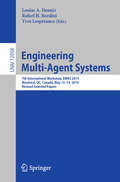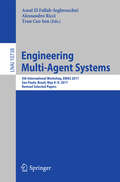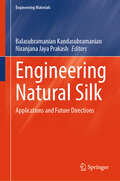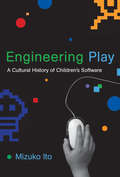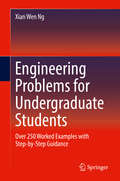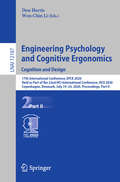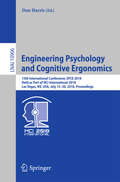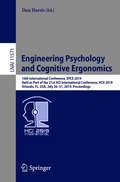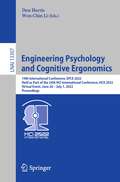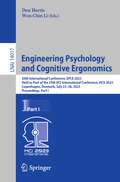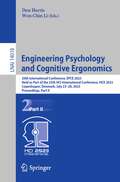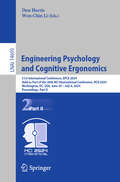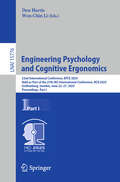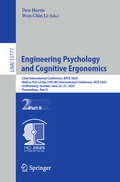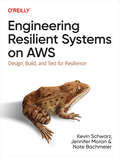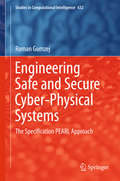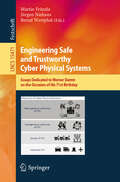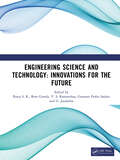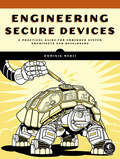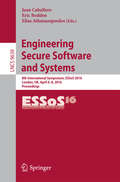- Table View
- List View
Engineering Multi-Agent Systems: 7th International Workshop, EMAS 2019, Montreal, QC, Canada, May 13–14, 2019, Revised Selected Papers (Lecture Notes in Computer Science #12058)
by Rafael H. Bordini Louise A. Dennis Yves LespéranceThis book constitutes the thoroughly refereed post-conference proceedings of the 7th International Workshop on Engineering Multi-Agent Systems, EMAS 2019, held in Montreal, QC, Canada, in May 2019. The 13 revised full papers presented in this book were carefully selected and reviewed from 20 submissions. The papers are grouped in the following topical sections: Multi-Agent Interaction and Organization; Simulation; Social Awareness and Explainability; Learning and Reconfiguration; and Implementation Techniques and Tools.
Engineering Multi-Agent Systems: 8th International Workshop, EMAS 2020, Auckland, New Zealand, May 8–9, 2020, Revised Selected Papers (Lecture Notes in Computer Science #12589)
by Cristina Baroglio Michael Winikoff Jomi F. HubnerThis book constitutes the thoroughly refereed post-conference proceedings of the 8th International Workshop on Engineering Multi-Agent Systems, EMAS 2020, held in Auckland, New Zealand, in May 2020. Due to COVID-19 pandemic the conference was held virtually. The 10 revised full papers presented in this book were carefully selected and reviewed from 16 submissions. The papers cover a broad range of topics in the domains of agent-oriented software engineering, programming multi-agent systems, declarative agent languages and technologies, artificial intelligence, and machine learning.
Engineering Multi-Agent Systems: 9th International Workshop, EMAS 2021, Virtual Event, May 3–4, 2021, Revised Selected Papers (Lecture Notes in Computer Science #13190)
by Brian Logan Matteo Baldoni Natasha AlechinaThis book constitutes revised selected papers from the 9th International Workshop on Engineering Multi-Agent Systems, EMAS 2021, which was held during May 3-4, 2021. The conference was initially planned to take place in London, UK, but changed to an online event due to the COVID-19 pandemic. The 20 full papers and 1 short paper included in this volume were carefully reviewed and selected from a total of 27 submissions. The contributions deal with agent-oriented software engineering, programming multi-agent systems, declarative agent languages and technologies, artificial intelligence, and machine learning.
Engineering Multi-Agent Systems: First International Workshop, Emas 2013, St. Paul, Mn, Usa, May 6-7, 2013, Revised Selected Papers (Theoretical Computer Science and General Issues #8245)
by Tran Cao Son Amal El Fallah-Seghrouchni Alessandro RicciThis book constitutes the revised and selected papers from the 5th International Workshop on Engineering Multi-Agent Systems held in Sao Paulo, Brazil, in May 2018, in conjunction with AAMAS 2018. The 11 full papers presented in this volume were carefully reviewed and selected from 18 submissions. The book contains also the best paper of the workshop that has been published previously in another LNCS volume. The EMAS workshop focusses on the cross-fertilisation of ideas and experiences in the various fields with the aim to enhance knowledge and expertise in MAS engineering , to improve the state-of-the-art, to define new directions for MAS engineering, to investigate how established methodologies for engineering and large-scale and open MAS can be adapted.
Engineering Natural Silk: Applications and Future Directions (Engineering Materials)
by Balasubramanian Kandasubramanian Niranjana Jaya PrakashThis book highlights the potential of silk in a vast array of applications, mainly in the field of medicine, electronics, and cosmetics. The silk proteins are generally contrived within the specialized glands of the arthropods, viz silkworms, spiders, and moths posterior to the biosynthesis occurring inside the epithelial cells. The unique conformational orientation comprising of hydrophobic crystalline beta-sheet domains and hydrophilic amorphous random coil structure, their tunability, presence of plenteous functional groups, mechanical strength, ease of regeneration, biocompatibility and biodegradability has enabled silk to grow beyond textile materials over last few decades making it an excellent alternative to synthetic polymers.
Engineering Play: A Cultural History of Children's Software (The John D. and Catherine T. MacArthur Foundation Series on Digital Media and Learning)
by Mizuko ItoHow the influential industry that produced such popular games as Oregon Trail and KidPix emerged from experimental efforts to use computers as tools in child-centered learning.Today, computers are part of kids' everyday lives, used both for play and for learning. We envy children's natural affinity for computers, the ease with which they click in and out of digital worlds. Thirty years ago, however, the computer belonged almost exclusively to business, the military, and academia. In Engineering Play, Mizuko Ito describes the transformation of the computer from a tool associated with adults and work to one linked to children, learning, and play. Ito gives an account of a pivotal period in the 1980s and 1990s, which saw the rise of a new category of consumer software designed specifically for elementary school-aged children. “Edutainment” software sought to blend various educational philosophies with interactive gaming and entertainment, and included such titles as Number Munchers, Oregon Trail, KidPix, and Where in the World Is Carmen Sandiego?.The children's software boom (and the bust that followed), says Ito, can be seen as a microcosm of the negotiations surrounding new technology, children, and education. The story she tells is both a testimonial to the transformative power of innovation and a cautionary tale about its limitations.
Engineering Problems for Undergraduate Students: Over 250 Worked Examples with Step-by-Step Guidance
by Xian Wen NgThis textbook supplement deconstructs some of the most commonly-encountered and challenging problems arising within engineering domains such as thermodynamics, separation processes, chemical kinetics, fluid dynamics, and engineering mathematics that are foundational to most engineering programs, as well as many courses in STEM disciplines. The book is organized into a series of 250 problems and worked solutions, with problems written in a format typical of exam questions. The book provides students ample practice in solving problems and sharpening their skill applying abstract theoretical concepts to solving exam problems. The presentation of detailed step-by-step explanations for each problem from start to finish in this book helps students follow the train of thought toward arriving at the final numerical solutions to the problems.Stands as an all-in-one, multidisciplinary, engineering problem-solving resource with comprehensive depth and breadth of coverage;Adopts a highly relevant question and answer pedagogy;Maximizes understanding through clear use of visuals;Emphasizes detailed, step-by-step explanations;Includes supplementary sections of cross-referenced concepts.
Engineering Psychology and Cognitive Ergonomics. Cognition and Design: 17th International Conference, EPCE 2020, Held as Part of the 22nd HCI International Conference, HCII 2020, Copenhagen, Denmark, July 19–24, 2020, Proceedings, Part II (Lecture Notes in Computer Science #12187)
by Don Harris Wen-Chin LiThis book constitutes the proceedings of the 17th International Conference on Engineering Psychology and Cognitive Ergonomics, EPCE 2020, held as part of the 22nd International Conference, HCI International 2020, which took place in Copenhagen, Denmark, in July 2020. The total of 1439 papers and 238 posters included in the 37 HCII 2020 proceedings volumes was carefully reviewed and selected from 6326 submissions.EPCE 2020 includes a total of 60 regular papers; they were organized in topical sections named: mental workload and performance; human physiology, human energy and cognition; cognition and design of complex and safety critical systems; human factors in human autonomy teaming and intelligent systems; cognitive psychology in aviation and automotive.As a result of the Danish Government's announcement, dated April 21, 2020, to ban all large events (above 500 participants) until September 1, 2020, the HCII 2020 conference was held virtually.
Engineering Psychology and Cognitive Ergonomics. Mental Workload, Human Physiology, and Human Energy: 17th International Conference, EPCE 2020, Held as Part of the 22nd HCI International Conference, HCII 2020, Copenhagen, Denmark, July 19–24, 2020, Proceedings, Part I (Lecture Notes in Computer Science #12186)
by Don Harris Wen-Chin LiThis book constitutes the proceedings of the 17th International Conference on Engineering Psychology and Cognitive Ergonomics, EPCE 2020, held as part of the 22nd International Conference, HCI International 2020, which took place in Copenhagen, Denmark, in July 2020. The total of 1439 papers and 238 posters included in the 37 HCII 2020 proceedings volumes was carefully reviewed and selected from 6326 submissions.EPCE 2020 includes a total of 60 regular papers; they were organized in topical sections named: mental workload and performance; human physiology, human energy and cognition; cognition and design of complex and safety critical systems; human factors in human autonomy teaming and intelligent systems; cognitive psychology in aviation and automotive.As a result of the Danish Government's announcement, dated April 21, 2020, to ban all large events (above 500 participants) until September 1, 2020, the HCII 2020 conference was held virtually.
Engineering Psychology and Cognitive Ergonomics: 15th International Conference, EPCE 2018, Held as Part of HCI International 2018, Las Vegas, NV, USA, July 15-20, 2018, Proceedings (Lecture Notes in Computer Science #10906)
by Don HarrisThis book constitutes the proceedings of the 14th International Conference on Engineering Psychology and Cognitive Ergonomics, EPCE 2018, held as part of the 20th International Conference, HCI International 2018, which took place in Las Vegas, Nevada, in July 2018. The total of 1171 papers and 160 posters included in the 30 HCII 2018 proceedings volumes was carefully reviewed and selected from 4346 submissions. EPCE 2018 includes a total of 57 papers; they were organized in topical sections named: mental workload and human error; situation awareness, training and team working; psychophysiological measures and assessment; interaction, cognition and emotion; and cognition in aviation and space.
Engineering Psychology and Cognitive Ergonomics: 16th International Conference, EPCE 2019, Held as Part of the 21st HCI International Conference, HCII 2019, Orlando, FL, USA, July 26–31, 2019, Proceedings (Lecture Notes in Computer Science #11571)
by Don HarrisThis book constitutes the proceedings of the 16th International Conference on Engineering Psychology and Cognitive Ergonomics, EPCE 2019, held as part of the 21st International Conference, HCI International 2019, which took place in Orlando, FL, USA, in July 2019.The total of 1274 papers and 209 posters included in the 35 HCII 2019 proceedings volumes was carefully reviewed and selected from 5029 submissions.EPCE 2019 includes a total of 34 regular papers; they were organized in topical sections named: mental workload and performance; visual cognition; cognitive psychology in aviation and space; and group collaboration and decision making.
Engineering Psychology and Cognitive Ergonomics: 18th International Conference, EPCE 2021, Held as Part of the 23rd HCI International Conference, HCII 2021, Virtual Event, July 24–29, 2021, Proceedings (Lecture Notes in Computer Science #12767)
by Don Harris Wen-Chin LiThis book constitutes the proceedings of the 18th International Conference on Engineering Psychology and Cognitive Ergonomics, EPCE 2021, held as part of the 23rd International Conference, HCI International 2020, held as a virtual event, in July 2021.The total of 1276 papers and 241 posters included in the 36 HCII 2021 proceedings volumes was carefully reviewed and selected from 5222 submissions. EPCE 2021 includes a total of 34 regular papers; they were organized in topical sections named: cognitive psychology in aviation; cognitive psychology in air traffic control; studies on cognitive processes; human error and human performance; and cognition and design.
Engineering Psychology and Cognitive Ergonomics: 19th International Conference, EPCE 2022, Held as Part of the 24th HCI International Conference, HCII 2022, Virtual Event, June 26 – July 1, 2022, Proceedings (Lecture Notes in Computer Science #13307)
by Don Harris Wen-Chin LiThis book constitutes the refereed proceedings of the 19th International Conference on Engineering Psychology and Cognitive Ergonomics, EPCE 2022, held as part of the 23rd International Conference, HCI International 2022, which was held virtually in June/July 2022. The total of 1271 papers and 275 posters included in the HCII 2022 proceedings was carefully reviewed and selected from 5487 submissions. The EPCE 2022 proceedings covers subjects such as advances in applied cognitive psychology that underpin the theory, measurement and methodologies behind the development of human-machine systems. Cognitive Ergonomics describes advances in the design and development of user interfaces.
Engineering Psychology and Cognitive Ergonomics: 20th International Conference, EPCE 2023, Held as Part of the 25th HCI International Conference, HCII 2023, Copenhagen, Denmark, July 23–28, 2023, Proceedings, Part I (Lecture Notes in Computer Science #14017)
by Don Harris Wen-Chin LiThis two-volume set LNCS 14017 - 14018 constitutes the thoroughly refereed proceedings of the 20th International Conference on Engineering Psychology and Cognitive Ergonomics, EPCE 2023, held as part of HCI International 2023 which took place in Copenhagen, Denmark, during July 23-28, 2023.A total of 1578 papers and 396 posters have been accepted for publication in the HCII 2023 proceedings from a total of 7472 submissions. The papers included in the HCII-EPCE volume set were organized in topical sections as follows: Part I: Stress, fatigue, and mental workload; human performance and error management; resilience and performance in demanding contexts. Part II: Human factors in aviation; human factors in operations management; human-centered design of autonomous systems.
Engineering Psychology and Cognitive Ergonomics: 20th International Conference, EPCE 2023, Held as Part of the 25th HCI International Conference, HCII 2023, Copenhagen, Denmark, July 23–28, 2023, Proceedings, Part II (Lecture Notes in Computer Science #14018)
by Don Harris Wen-Chin LiThis two-volume set LNCS 14017 - 14018 constitutes the thoroughly refereed proceedings of the 20th International Conference on Engineering Psychology and Cognitive Ergonomics, EPCE 2023, held as part of HCI International 2023 which took place in Copenhagen, Denmark, during July 23-28, 2023.A total of 1578 papers and 396 posters have been accepted for publication in the HCII 2023 proceedings from a total of 7472 submissions. The papers included in the HCII-EPCE volume set were organized in topical sections as follows: Part I: Stress, fatigue, and mental workload; human performance and error management; resilience and performance in demanding contexts. Part II: Human factors in aviation; human factors in operations management; human-centered design of autonomous systems.
Engineering Psychology and Cognitive Ergonomics: 21st International Conference, EPCE 2024, Held as Part of the 26th HCI International Conference, HCII 2024, Washington, DC, USA, June 29 – July 4, 2024, Proceedings, Part I (Lecture Notes in Computer Science #14692)
by Don Harris Wen-Chin LiThis two-volume set LNAI 14692–14693 constitutes the thoroughly refereed proceedings of the 21st International Conference on Engineering Psychology and Cognitive Ergonomics, EPCE 2024, held as part of HCI International 2024,held in Washington, DC, USA, during June 29 - July 4, 2024. The total of 1271 papers and 309 posters included in the HCII 2024 proceedings was carefully reviewed and selected from 5108 submissions. The papers included in the HCII-EPCE two-volume set were organized in topical sections as follows: Part I: Cognitive Processes and Performance in High-Stress Environments; Decision-Making Support and Automation. Part II: Engineering Psychology and User Experience; Human Factors in Aviation.
Engineering Psychology and Cognitive Ergonomics: 21st International Conference, EPCE 2024, Held as Part of the 26th HCI International Conference, HCII 2024, Washington, DC, USA, June 29 – July 4, 2024, Proceedings, Part II (Lecture Notes in Computer Science #14693)
by Don Harris Wen-Chin LiThis two-volume set LNAI 14692–14693 constitutes the thoroughly refereed proceedings of the 21st International Conference on Engineering Psychology and Cognitive Ergonomics, EPCE 2024, held as part of HCI International 2024,held in Washington, DC, USA, during June 29 - July 4, 2024. The total of 1271 papers and 309 posters included in the HCII 2024 proceedings was carefully reviewed and selected from 5108 submissions. The papers included in the HCII-EPCE two-volume set were organized in topical sections as follows: Part I: Cognitive Processes and Performance in High-Stress Environments; Decision-Making Support and Automation. Part II: Engineering Psychology and User Experience; Human Factors in Aviation.
Engineering Psychology and Cognitive Ergonomics: 22nd International Conference, EPCE 2025, Held as Part of the 27th HCI International Conference, HCII 2025, Gothenburg, Sweden, June 22–27, 2025, Proceedings, Part I (Lecture Notes in Computer Science #15776)
by Don Harris Wen-Chin LiThis two-volume set constitutes the thoroughly refereed proceedings of the 22nd International Conference on Engineering Psychology and Cognitive Ergonomics, EPCE 2025, held as part of HCI International 2025, held in Gothenburg, Sweden, during June 22–27, 2025. Two volumes of the HCII 2025 proceedings are dedicated to this year&’s edition of the EPCE conference. The first volume centers around a diverse array of interconnected themes related to human performance, workload and situational awareness in the use of complex interactive applications and environments, as well as the role of cognitive psychology on designing and evaluating interactive systems and investigating computer-supported as in collaboration and teaming. The second volume focuses on issues related to Cognitive Psychology in the demanding contexts of aviation and space.
Engineering Psychology and Cognitive Ergonomics: 22nd International Conference, EPCE 2025, Held as Part of the 27th HCI International Conference, HCII 2025, Gothenburg, Sweden, June 22–27, 2025, Proceedings, Part II (Lecture Notes in Computer Science #15777)
by Don Harris Wen-Chin LiThis two-volume set constitutes the thoroughly refereed proceedings of the 22nd International Conference on Engineering Psychology and Cognitive Ergonomics, EPCE 2025, held as part of HCI International 2025, held in Gothenburg, Sweden, during June 22–27, 2025. Two volumes of the HCII 2025 proceedings are dedicated to this year&’s edition of the EPCE conference. The first volume centers around a diverse array of interconnected themes related to human performance, workload and situational awareness in the use of complex interactive applications and environments, as well as the role of cognitive psychology on designing and evaluating interactive systems and investigating computer-supported as in collaboration and teaming. The second volume focuses on issues related to Cognitive Psychology in the demanding contexts of aviation and space.
Engineering Resilient Systems on AWS: Design, Build, and Test for Resilience
by Nate Bachmeier Kevin Schwarz Jennifer MoranTo ensure that applications are reliable and always available, more businesses today are moving applications to AWS. But many companies still struggle to design and build these cloud applications effectively, thinking that because the cloud is resilient, their applications will be too. With this practical guide, software, DevOps, and cloud engineers will learn how to implement resilient designs and configurations in the cloud using hands-on independent labs.Authors Kevin Schwarz, Jennifer Moran, and Dr. Nate Bachmeier from AWS teach you how to build cloud applications that demonstrate resilience with patterns like back off and retry, multi-Region failover, data protection, and circuit breaker with common configuration, tooling, and deployment scenarios. Labs are organized into categories based on complexity and topic, making it easy for you to focus on the most relevant parts of your business.You'll learn how to:Configure and deploy AWS services using resilience patternsImplement stateless microservices for high availabilityConsider multi-Region designs to meet business requirementsImplement backup and restore, pilot light, warm standby, and active-active strategiesBuild applications that withstand AWS Region and Availability Zone impairmentsUse chaos engineering experiments for fault injection to test for resilienceAssess the trade-offs when building resilient systems, including cost, complexity, and operational burden
Engineering Safe and Secure Cyber-Physical Systems
by Roman GumzejThis book introduces the concept of holistic designand development of cyber physical systems to achieve their safe and secureoperation. It shows that by following the standards for embedded system'ssafety and using appropriate hardware and software components inherently safesystem's architectures can be devised and certified. While the standardsalready enable testing and certification of inherently safe and sound hardware,this is still not the case with software. The book demonstrates that SpecificationPEARL(SPEARL) addresses this issue and proposes appropriate solutions from theviewpoints of software engineering as well as concrete program components. Bydoing so it reduces the complexity of cyber physical systems design in aninnovative way. Three ultimate goals are being followed in thecourse of defining this new PEARL standard, namely: 1. simplicity over complexity, 2. inherent real-time ability, and 3. conformity to safety integrity and securitycapability levels.
Engineering Safe and Trustworthy Cyber Physical Systems: Essays Dedicated to Werner Damm on the Occasion of His 71st Birthday (Lecture Notes in Computer Science #15471)
by Martin Fränzle Jürgen Niehaus Bernd WestphalThis Festschrift is dedicated to Werner Damm, a pioneering researcher and practitioner in cyber-physical systems. Werner received his PhD in 1981 from RWTH Aachen and held the Chairs for Computer Architecture and Safety Critical Systems at Carl von Ossietzky Universität Oldenburg, from where he coordinated foundational research projects such as the Collaborative Research Center Automatic Verification and Analysis of Complex Systems, AVACS, funded by the German Science Foundation. He has been a founder or board member of many projects, associations, companies, and events, including the applied research institute OFFIS; BTC Embedded Systems, providing testing solutions for automotive systems; SafeTRANS, a non-profit industrial and academic association coordinating strategies and knowledge transfer in the area of safety relevant systems; and numerous conferences. He has been a scientific board member or expert advisor to the German Institute for Artificial Intelligence, DFKI; the ECSEL and Artemis public-private partnerships of the European Commission; the German Aerospace Center, DLR; the Helmholtz Association; and the US National Science Foundation. He is a member of the German National Academy of Technical Sciences, acatech. Werner Damm&’s work has spanned mathematical models of embedded systems, systems-of-systems, cyber physical systems, specification languages, hybrid discrete-continuous systems, formal verification methods, automatic synthesis from formal specifications, and analysis of real-time and safety-critical behavior, complemented by applied research with industrial partners in avionics, automotive, space, and medical systems. Throughout his career he has been motivated to render digitally controlled systems safe, societally acceptable, and beneficial. The contributions in this volume reflect how he has inspired many researchers and practitioners across disciplines who share this ambition.
Engineering Science and Technology: Innovations for the Future
by S. R. Reeja Bore Gowda Y. S. Rammohan Ganesan Prabu Sankar G. JayalathaThe International Conference on Recent Innovations in Engineering Science & Technology (ICRIET-2025), hosted by KSIT Bengaluru, brought together researchers and experts from around the world to present 225 peer reviewed papers across four engineering domains. With keynote sessions on AI, energy harvesting, and sustainable manufacturing, the conference promoted interdisciplinary dialogue and cutting-edge innovation. It served as a dynamic platform for academic exchange, fostering collaboration between academia and industry. ICRIET-2025 stands as a testament to KSIT’s commitment to advancing research and technological progress.
Engineering Secure Devices: A Practical Guide for Embedded System Architects and Developers
by Dominik MerliThis practical guide to building embedded and IoT devices securely is an essential resource for current and future developers tasked with protecting users from the potential threats of these ubiquitous devices.As an engineer, you know that countless devices—from industrial components to smart household appliances—rely on embedded computer systems. But how do you balance the need for robust security with performance and innovative product design?Engineering Secure Devices will guide you through crafting secure devices—from protecting crucial assets to the nature of attackers and the risks they pose. You&’ll explore the technical intricacies and pros and cons of symmetric and asymmetric cryptography and learn how to use and analyze random number generators and cryptographic algorithms. You&’ll learn how to ensure confidential data storage and secure memory, and devise secure device identity solutions and communication protocols to reinforce system architecture against potential threats. And finally, you&’ll learn how to properly design secure boot and secure update processes, manage access control, and perform system monitoring to secure IoT devices.Real-world case studies throughout highlight practical applications, solutions, and obstacles, such as firmware updates with SWUpdate, secure communication with MQTT, and advanced access control with AppArmor.You&’ll also dig into topics like: Analyzing the performance of cryptographic implementations in both hardware and softwareConsiderations for secure boot and software update processes to ensure ongoing firmware integrityDesigning robust device architectures that withstand attacks while maintaining critical operationsDeveloping strategies to detect and respond to anomalies or security breaches in embedded systemsWhether you&’re an IoT developer or an embedded system architect, Engineering Secure Devices equips you with the indispensable knowledge to design, secure, and support the next generation of smart devices—from webcams to four-legged robots.
Engineering Secure Software and Systems
by Juan Caballero Eric Bodden Elias AthanasopoulosThis book constitutes the refereed proceedings of the 8th International Symposium on Engineering Secure Software and Systems, ESSoS 2016, held in London, UK, in April 2016. The 13 full papers presented together with 3 short papers and 1 invited talk were carefully reviewed and selected from 50 submissions. The goal of this symposium, is to bring together researchers and practitioners to advance the states of the art and practice in secure software engineering. The presentations and associated publications at ESSoS 2016 contribute to this goal in several directions: First, by improving methodologies for secure software engineering (such as flow analysis and policy compliance). Second, with results for the detection and analysis of software vulnerabilities and the attacks they enable. Finally, for securing software for specific application domains (such as mobile devices and access control).
